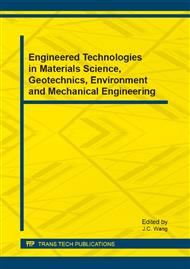p.133
p.139
p.145
p.150
p.157
p.162
p.166
p.172
p.177
Construction of Prokaryotic Expression Vector Containing Flocculation Gene FLO5 and Expression of FLO5 in E. coli
Abstract:
FLO5 has been identified as a dominant flocculation gene. The goal of this study is to clone the FLO5 gene from Saccharomyces cerevisiae and express it in E. coli. In this study, the FLO5 gene amplified by PCR from S. cerevisiae was cloned into prokaryotic expression vector pET-28a to form expression vector pET28a-FLO5, finally, transferred into E.coli BL21. Methods: FLO5 gene was amplified by PCR from genomic DNA extracted from Saccharomyces cerevisiae. The amplified FLO5 gene fragment was then recombined with clone vector pMD18-T to form clone vector pMD18-T-FLO5 amplified in E.coli JM109. After confirmed with sequencing, FLO5 fragment cut out from pMD18-T-FLO5 by enzyme EcoRI and NotI was recombined into expression vector pET-28a to form vector pET28a-FLO5. Vector pET28a-FLO5 was then transferred into E. coli BL21 and protein FLO5 was expressed in E. coli BL21 by the induction with IPTG. Expressed protein fragments separated by SDS-PAGE showed a band with the size of protein FLO5 suggesting the expression of gene FLO5. with the expected This study will lay the foundation for further research in studying flocculating effect of exogenous protein expressed by genetic engineering and making new flocculating agent through recombinant engineering.
Info:
Periodical:
Pages:
157-161
Citation:
Online since:
February 2013
Authors:
Keywords:
Price:
Сopyright:
© 2013 Trans Tech Publications Ltd. All Rights Reserved
Share:
Citation:


